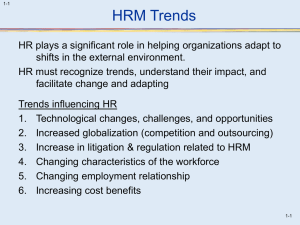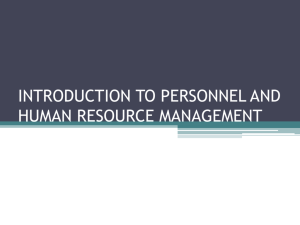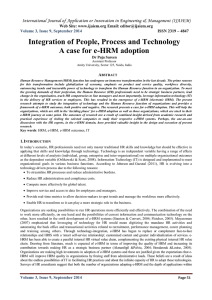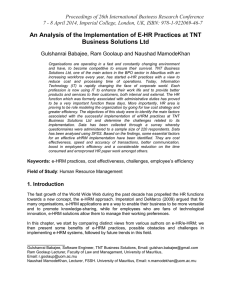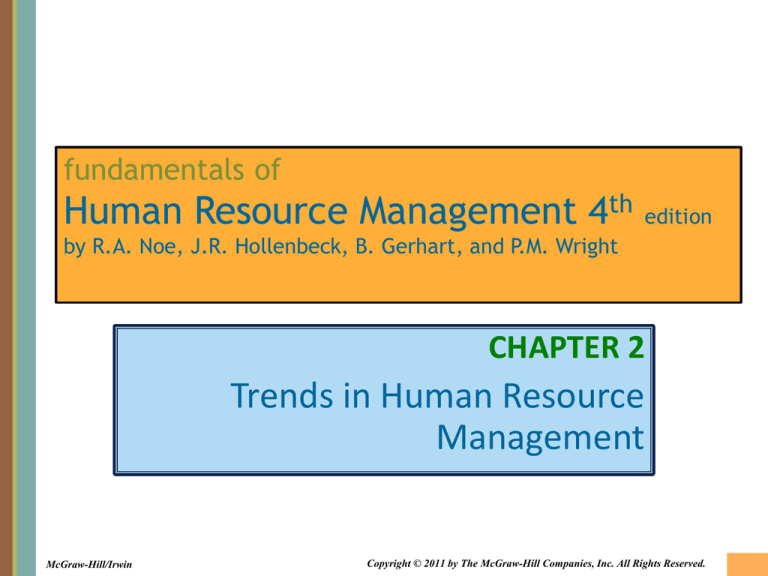
fundamentals of
Human Resource Management 4th
edition
by R.A. Noe, J.R. Hollenbeck, B. Gerhart, and P.M. Wright
CHAPTER 2
Trends in Human Resource
Management
McGraw-Hill/Irwin
Copyright © 2011 by The McGraw-Hill Companies, Inc. All Rights Reserved.
2-1
What Do I Need to Know?
1. Describe trends in the labor force composition
and how they affect human resource
management.
2. Summarize areas in which human resource
management can support the goal of creating
a high-performance work system.
3. Define employee empowerment and explain
its role in the modern organization.
2-2
What Do I Need to Know? (continued)
4. Identify ways HR professionals can support
organizational strategies for quality, growth,
and efficiency.
5. Summarize ways in which HRM can support
organizations expanding internationally.
6. Discuss how technological developments are
affecting human resource management.
2-3
What Do I Need to Know? (continued)
7. Explain how the nature of the employment
relationship is changing.
8. Discuss how the need for flexibility affects
human resource management.
2-4
The Labor Force
Internal Labor Force
• An organization’s workers
– Its employees
– The people who have
contracts to work at the
organization
• The internal labor force
has been drawn from the
external labor market.
External Labor Market
• Individuals who are
actively seeking
employment.
• The number and kinds of
people in the external
labor market determine
the kinds of human
resources available to an
organization.
2-5
Change in the Labor Force
An Aging Workforce
A Diverse Workforce
Skill Deficiencies of the
Workforce
2-6
Figure 2.1: Age Distribution of U.S Labor
Force, 2008 and 2018
2-7
HRM Implications of the Aging Workforce
• HR professionals will spend much of their time on
concerns related to retirement planning, retraining
older workers, and motivating workers whose careers
have reached a plateau.
• Organizations will struggle with ways to control the
rising costs of health care and other benefits.
• Many of tomorrow’s managers will supervise
employees much older than themselves.
• Organizations will have to find ways to attract, retain,
and prepare the youth labor force.
2-8
• As more and more of
the workforce reaches
retirement age, some
companies have set up
mentoring programs
between older and
younger workers so that
knowledge is not lost
but passed on.
2-9
Figure 2.2: Projected Racial/Ethnic
Makeup of the U.S. Workforce, 2018
2-10
Figure 2.3: HRM Practices That Support
Diversity Management
2-11
Skill Deficiencies in Workforce
A = True B = False
• Use of computers to do routine tasks has
changed the kinds of skills needed by
employees.
• A college degree is not as important as it once
was.
• U.S. production jobs require intelligence and
skills as much as strength.
2-12
Skill Deficiencies of the Workforce
• Today, employers are
looking for:
–
–
–
–
mathematical skills
verbal skills
interpersonal skills
computer skills
• The gap between skills
needed and skills
available has decreased
companies ability to
compete.
• They sometimes lack
the capacity to upgrade
technology, reorganize
work, and empower
employees.
2-13
High-Performance Work Systems
• Organizations that have the best possible fit
between their:
– social system (people and how they interact); and
– technical system (equipment and processes).
• Key trends occurring in today’s highperformance work systems:
– reliance on knowledge workers
– the empowerment of employees to make decisions
– the use of teamwork
2-14
Knowledge Workers
• Employees whose
contribution to the
organization is
specialized knowledge,
such as:
– knowledge of customers
– knowledge of a process
– knowledge of a
profession
• They are especially
needed for jobs in:
–
–
–
–
–
health services
business services
social services
engineering
management
2-15
Top 10 Occupations for Job Growth
2-16
Test Your Knowledge
• Ensuring that knowledge workers will share
information and store it so that it is easily
retrieved by others is the concern of which of
the following HR activities.
A.
B.
C.
D.
Turnover
Employee Empowerment
Knowledge Management
Employee Selection
2-17
Employee Empowerment
Employee Empowerment
• Giving employees
responsibility and
authority to make
decisions regarding all
aspects of product
development or
customer service.
Employee Engagement
• Full involvement in
one’s work and
commitment to one’s
job and company.
• This is associated with:
– higher productivity
– better customer service
– lower employee
turnover
2-18
Teamwork
• The assignment of work
to groups of employees
with various skills who
interact to assemble a
product or provide a
service.
• Work teams often
assume many of the
activities traditionally
reserved for managers:
– selecting new team
members
– scheduling work
– coordinating work with
customers and other
units of the organization
2-19
Test Your Knowledge
• Sharon is a very smart and conscientious
worker. Lately, she has felt that her ideas
were disregarded and she was denied
autonomy in completing her work. This
situation is probably caused by a lack of
A.
B.
C.
D.
Employee Empowerment
Knowledge Management
Turnover
Teamwork
2-20
Figure 2-4: Strategic Business Issues
Affecting HRM
2-21
Total Quality Management (TQM)
TQM is a companywide effort to continuously
improve the ways people, machines, and
systems accomplish work.
The TQM approach provides guidelines for all
the organization’s activities, including HRM.
2-22
TQM Core Values
• Methods and processes are designed to meet the
needs of internal and external customers.
• Every employee in the organization receives training in
quality.
• Quality is designed into a product or service so that
errors are prevented from occurring.
• The organization promotes cooperation with vendors,
suppliers, and customers to improve quality and hold
down costs.
• Managers measure progress with feedback based on
data.
2-23
Mergers and Acquisitions
• HRM should have a significant role in carrying
out a merger or acquisition.
– Differences between the businesses involved in
the deal make conflict inevitable.
– Training should include developing conflict
resolution skills.
– There is a need to sort out differences in the two
companies’ practices with regard to
compensation, performance appraisal, and other
HR systems.
2-24
Figure 2.5: Number of Employees Laid Off
During the Past Decade
2-25
Reengineering
• A complete review of the organization’s critical
work processes to make them more efficient
and able to deliver higher quality.
• Involves reviewing all the processes
performed by all the organization’s major
functions.
– This includes human resources management.
2-26
Reengineering (continued)
• Reengineering affects human resource
management in two ways:
1. The way the HR department itself accomplishes
its goals may change dramatically.
2. The fundamental change throughout the
organization requires the HR department to help
design and implement change so that all
employees will be committed to the success of
the reengineered organization.
2-27
Outsourcing
• Outsourcing – the practice of having another
company (a vendor, third-party provider, or
consultant) provide services.
• Outsourcing gives the company access to indepth expertise and is often more economical
as well.
• HR departments help with a transition to
outsourcing.
2-28
Expanding into Global Markets
Offshoring
• Moving operations from
the country where a
company is headquartered
to a country where pay
rates are lower but the
necessary skills are
available.
The International Labor Pool
• Hiring at home may may
involve selection of
employees from other
countries.
• The beginning of the 21st
century has seen
significant immigration.
2-29
Figure 2.6:
Where
Immigrants to
the U.S. Came
from in 2008
2-30
International Assignments
• Besides hiring an international workforce,
organizations must be prepared to send
employees to other countries.
• This requires HR expertise in selecting and
preparing employees for international
assignments.
• Employees who take assignments in other
countries are called expatriates.
2-31
Table 2.1:
New Technologies Influencing HRM
2-32
Human Resource Information System
(HRIS)
• A computer system used to acquire, store,
manipulate, analyze, retrieve, and distribute
information related to an organization’s human
resources. An HRIS can:
–
–
–
–
support strategic decision making
help the organization avoid lawsuits
provide data for evaluating programs or policies
support day-to-day HR decisions
2-33
Electronic Human Resource Management
(e-HRM)
e-HRM: the processing and transmission of
digitized HR information especially using
computer networking and the Internet.
e-HRM has the potential to change all
traditional HRM functions.
Self-Service: System in which employees have
online access to information about HR issues
and go online to enroll themselves in programs
and provide feedback through surveys
2-34
Table 2.2: Implications of e-HRM for HRM
Practices
2-35
Change in the Employment Relationship
A New
Psychological
Contract
Flexibility
Flexible
Staffing Levels
Flexible Work
Schedules
2-36
The Nature of the Employment
Relationship is Changing
• The employment relationship takes the form of a
“psychological contract” that describes what
employees and employers expect from the
employment relationship.
• In the traditional version, organizations expected
employees to contribute time, effort, skills, abilities,
and loyalty in exchange for job security and
opportunities for promotion.
• Today, organizations’ needs are constantly changing.
2-37
The Nature of the Employment
Relationship is Changing (continued)
• Today, organizations are requiring top performance
and longer work hours but cannot provide job
security.
• Instead, employees are looking for:
–
–
–
–
–
flexible work schedules
comfortable working conditions
greater autonomy
opportunities for training and development
performance-related financial incentives
• This requires planning for flexible staffing levels.
2-38
Flexibility: A Family-Friendly Work
Arrangement
2-39
The Need for Flexibility Affects HRM
• Organizations seek flexibility in staffing levels
through alternatives to the traditional employment
relationship:
– outsourcing, temporary, and contract workers
– flexible work schedules – including shortened work weeks
– allowing employees to adjust work hours to meet personal
and family needs
– moving employees to different jobs to meet changes in
demand
2-40
Summary
• An organization’s internal labor force comes from its
external labor market
• In the U.S., this labor market is aging and becoming
more racially and ethnically diverse.
• Organizations must recruit from a diverse population,
establish bias-free HR systems, and help employees
understand and appreciate cultural differences.
• HRM can help organizations find and keep the best
possible fit between their social system and technical
system.
2-41
Summary (continued)
• Job design and appropriate systems for assessment
and rewards have a central role in supporting
employee empowerment and teamwork.
• Employee empowerment means giving employees
responsibility and authority to make decisions
regarding all aspects of product development or
customer service.
• HRM must design jobs to give employees latitude for
decision-making and interpersonal skills.
2-42
Summary (continued)
• HR professionals should be familiar with the
organization’s strategy and may even play a role in
developing the strategy.
• Specific HR practices vary according to type of
strategy.
• Organizations with international operations hire
employees in foreign countries where they operate,
so they need knowledge of differences in culture and
business practices.
2-43
Summary (continued)
• Information systems have become a tool for more HR
professionals, and often these systems are provided
through the Internet.
• Online information sharing enables employee selfservice for many HR needs.
• The employment relationship takes the form of a
“psychological contract” that describes what
employees and employers expect from the
employment relationship.
• The traditional employment relationship is changing.
2-44
Summary (continued)
• Organizations seek flexibility in staffing levels
through alternatives to the traditional employment
relationship.
• Organizations also may seek flexible work schedules.
– Shortened workweeks
– Adjust work hours as a way for employees to meet
personal needs
2-45

